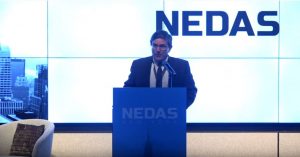As many are already aware, the 5G future is fast approaching. However, there are still a few hurdles to jump before rollout becomes ubiquitous and accessible for all businesses. For instance, empowering network densification, creating connectivity to support new capabilities, accommodating huge data volumes and other similar challenges are all key to capable 5G service. One solution that has emerged to meet the needs of dynamic spectrum management and added network capacity in in-building or small cell systems is CBRS (Citizens Broadband Radio Service).
As an event focused on education and collaboration at the intersection of wireless and wireline, the 2019 NEDAS NYC Summit offered attendees an opportunity to learn more about CBRS, a vital enabler of tech and telecom’s future, with a keynote from Andrew Clegg, Spectrum Engineering Lead for Google. Why Google? Well, Google is one of the six entities serving as a SAS provider (keep reading to find out why this is important). Additionally, as an internet company that is invested in enabling internet connection, radio spectrum — a necessary foundation for mobile device operation — is of critical concern for Google.
As an introduction to CBRS, Clegg notes that there are several characteristics of this strategy that differentiate it from other types of wireless service, the first being that it is a shared spectrum initiative. Essentially, CBRS operates in a spectrum that includes other occupants — the other occupant being the U.S. Department of Defense (DoD). Another important aspect is that there are two tiers of service when it comes to CBRS; a Priority Access License provides interference protection and assurance of band access (these are to be auctioned by the FCC on June 25, 2020), while up to 150 megahertz (MHz) of free access to the spectrum is also available without the aforementioned protections.
With a large ecosystem of equipment already in place, a user of CBRS could, in theory, start up their own wireless service instead of using a Distributed Antenna System (DAS) to employ another wireless provider’s service in commercial real estate, residential buildings and beyond. In essence, CBRS is presenting a unique, more cost-effective spectrum access model to businesses across the technology and telecom sectors as they head into the digital future.
So, in Clegg’s words, CBRS has the potential to be a “critical complement, or even change, to the way DAS services [or small cells] are offered and deployed.” However, there are also a few key targets to keep in mind when making sure that CBRS functions in a way that successfully offers these benefits to users. To start, users must ensure they are not interfering with DoD use. To accomplish this, Clegg explains that a CBSD (a CBRS base station) must be in positive control of a Spectrum Access System (SAS): a checkpoint that ensures that a CBSD will not interrupt DoD use both before going on air and throughout its use of the band. This is critical, as CBRS is utilized for ship radars, which can pop up unpredictably in different locations and at different times.
As an industry that is currently being bogged down by a limited amount of already highly occupied spectrum, it’s clear that CBRS’ shared spectrum approach may be the key to unlocking new network opportunities that will pave the way for 5G enablement. As we head into the future, Google is working to find ways to make this spectrum sharing work and enable next-generation wireless service. With tools like Google Earth and other in-building mapping solutions, the company offers insight into how radio propagation will be affected by its surroundings and beyond. With CBRS looking at commercial service rollout in the very near future, the global community can expect expanded opportunity for its digital future with this exciting new network strategy.
To view the entire keynote, please click here.
To learn more about NEDAS, please visit www.nedas.com.






